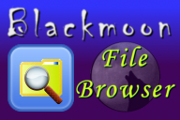
Contents:
- Q: How do I create a Home screen shortcut?
- Tip: Swipe a file to quickly Send it to another app.
- Q: How do I create a Playlist of my music?
- Q: How do I make an audio or music file a ringtone or alarm?
- Q: Oops! I accidentally deleted a file, how can I undo the delete?
- Tip: Pushing the grid detail view down to move it out of the way.
- Tip: Navigation of Virtual Folders (§)
 Q: What does the picture icon with a warning sign and two arrows represent? Is my image file broken?
Q: What does the picture icon with a warning sign and two arrows represent? Is my image file broken?
Q: How do I create a Home screen shortcut?
- Long Press on an empty spot on your Home screen.
- A popup menu will appear. Tap the Shortcuts menu item.
- Two kinds of shortcuts are available:
- Tap the “Create Jump Point” menu item to open File Browser and pick a folder/file to create a Jump Point. Tapping on a Jump Points will open up File Browser and navigate to your chosen Jump Point.
- Tap the “File” menu item to open File Browser and pick a folder/file to create a File shortcut. Tapping on a File shortcut will open up the file as if you tapped on it from within the File Browser itself, avoiding the need to open up a File Browser at all. If the file is an image or video, a thumbnail will be created and used for the shortcut.
Tip: Swipe a file to quickly Send it to another app.
Swiping a file to the left or right will act the same as if you long pressed on the file and picked the “Send to…” menu item.
Q: How do I create a Playlist of my music?
- Mark two or more music files individually or a folder containing only music files.
- Press the Menu button, choose Mark Actions followed by Send Marked To …
- Choose Create Playlist in the list that pops up.
- Give your playlist a name and choose where you wish to save it.
- Click the save button.
- Your new playlist will be automatically detected and imported by the music player.
Q: How do I make an audio or music file a ringtone or alarm?
- Long press on the file you want to be a ringtone.
- Choose “Make Available to…”
- Press the check box you want to use. Once checked, it is immediately available.
- A shortcut button to your phone’s Audio Settings menu may be available if your phone supports it.
- Once in your device’s Audio Settings, your new ringtone will appear in the list of available ringtones.
Q: Oops! I accidentally deleted a file, how can I undo the delete?
If you are using the Recycle Bin feature (ON by default), you can undo the delete. Otherwise, it is permanent. The Recycle Bin will hold files for up to 3 days before deleting them permanently.
- Press the “Jump To” button.
- In the popup window, press the “Recycle Bin” button.
- Browse to the file you wish to recover.
- Mark it and then use “Move Marked to” to move it out of the Recycle Bin.
Tip: Pushing the grid detail view down to move it out of the way.
If you are using grid view and large thumbnails, images can get in the way on a small screen. You can either tap the file name area or swipe down the image to push it down and out of the way.
Tip: Navigation of Virtual Folders (§)
If you see the § symbol as a part of a folder’s detailed information, it denotes that the folder is a Virtual Folder (a.k.a. Symbolic Link). These folders look and act like any other folder, but they don’t really exist where you see them. They are physically located somewhere else in the file system. If you are curious about where the contents of the folder are actually located, you can use the “Open §” menu item. Virtual Folders are created by the device to make it easier to find certain locations and to allow a wide variety of devices with different folder structures to have a single point of entry regardless if it actually exists or not. For example, “/sdcard” is an actual folder in older Android devices, but on 2.0+ devices it is a virtual one that is actually located in “/mnt/sdcard”. The “/sdcard” Virtual Folder is provided so that older apps relying on “/sdcard” would not break. Please note that you cannot create Virtual Folders with File Browser. I merely provided a means to satisfy my own curiosity. =)
![]()
Q: What does the picture icon with a warning sign and two arrows represent? Is my image file broken?
If you see this icon instead of the actual thumbnail of the image, it means that your device (phone, tablet, notebook, etc.) may not have enough program memory space to properly open and view the image. Some devices have terrible reactions if you try to open such a file: anywhere from locking it up, rebooting it, killing the app and all other apps currently running, showing a blank screen, or possibly actually working correctly anyway. I am currently working with Google engineers to try and pinpoint the issue so they can fix it and then I will be able to better account for such large images… as well as explain the issue better =).

Can your program display 2 panes concurrently to simplify file operations ?
It cannot display 2 concurrent panes, yet, no.